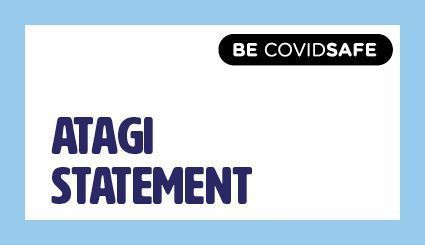
Following the recent approval of the Therapeutic Goods Administration for provisional registration of the Comirnaty (Pfizer) COVID-19 vaccine to be extended from people aged 16 years and over to include children aged 12-15 years, the Australian Technical Advisory Group on Immunisation (ATAGI) has reviewed available data on the safety and efficacy of the Comirnaty (Pfizer) COVID-19 vaccine in children aged 12-15 years, the risk of COVID‑19 in this age group, and evidence of wider benefits and risks of vaccinating children.
ATAGI has also reviewed available evidence on specific medical conditions in children that have been identified to be associated with an increased risk of severe COVID-19.
ATAGI recommends that the following groups of children among those aged 12-15 years be prioritised for vaccination using the Comirnaty (Pfizer) vaccine:
- children with specified medical conditions that increase their risk of severe COVID-19 (including asthma, diabetes, obesity, cardiac and circulatory congenital anomalies, neuro developmental disorders, epilepsy, immuno-compromised and trisomy 21) – see Appendix A for more details
- Aboriginal and Torres Strait Islander children aged 12-15 years
- all children aged 12-15 years in remote communities, as part of broader community outreach vaccination programs that provide vaccines for all ages (≥12 years).
ATAGI will make recommendations to Government for use in all other children in the 12-15 years age group within the coming months, following review of emerging information on:
- the safety and effectiveness of COVID-19 vaccines in adolescents from overseas vaccination programs
- the incidence, risk factors and outcomes of cases of myocarditis after receiving Comirnaty in adolescents and young adults reported overseas
- results of mathematical modelling on the overall population level impact of vaccination benefits from including vaccinating adolescents as part of various population vaccination strategy options
- evidence to inform the optimal timing and schedule of vaccination in adolescents, both in terms of dose number and spacing.
Summary of supporting evidence on medical conditions with increased risk of severe COVID-19 in children
Preliminary evidence suggests that children and adolescents have a lower susceptibility to
SARS-CoV-2 compared to adults, and play a lesser role in transmission at a population level.1,2 Healthy children also have a much lower risk of severe illness from COVID-19 than adults, and typically exhibit a mild course of illness.3
Several publications have reported, however, that children, adolescents and young adults with underlying medical conditions have an increased likelihood of developing severe disease and complications when infected with SARS-CoV-2. Only a limited number of studies provided data on these risk associations stratified by selected specific medical conditions; most other published studies reported only by broad disease groups.
A review of evidence identified three studies (two from the USA and one from the UK) that provided data on risk or odds association with severe COVID-19 in the younger age groups, stratified by selected specific underlying risk conditions.4-6 (Note that these studies were undertaken in 2020 or early 2021, and therefore do not reflect the epidemiology related to the more recently emerged variants such as the Delta variant.)
One of these studies also specifically assessed any increase in risk of severe disease among children with chronic disease (non-complex or complex) defined by established algorithms, compared with those without chronic disease.4
Brief summary of evidence on efficacy and safety on use of Comirnaty in adolescents
Safety and efficacy of Comirnaty in children
A phase II-III trial of Comirnaty, which included 2260 adolescents aged 12 to 15 years, found a vaccine efficacy against symptomatic COVID-19 in this age cohort of 100% (95% CI 75.3 – 100) from 7 days after the second dose in participants with or without evidence of previous infection.7
Three COVID-19 cases were reported after the first dose and before the second (within 11 days after dose 1) among vaccine recipients, compared with 12 cases among placebo recipients (vaccine efficacy 75% (95% CI: 7.6 – 95.5). No cases of severe COVID-19 were observed in this age cohort. The neutralising antibody response after 2 doses was higher among those aged 12-15 years than those aged 16-25 years.
The most common adverse event was injection site pain (79-86%), followed by fatigue (60-66%) and headache (55-65%).7 Fever occurred in 20% of participants who received Comirnaty, and was slightly more frequent in those aged 12-15 (37%) than in those aged 16-25 (32%). Systemic adverse events were more common after the second dose. No vaccine-related serious adverse events were reported from the clinical trial.
Myocarditis and/or pericarditis in adolescents following mRNA COVID-19 vaccines
Myocarditis and/or pericarditis have recently been reported overseas in adolescents aged 12 and older and in adults, following mRNA COVID-19 vaccines including Comirnaty, more commonly in males and most commonly after the second dose.8,9 The risk of these conditions appears higher in adolescents compared to adults.
In an analysis of US Vaccine Adverse Event Reporting System data, crude reporting rates were 40.6 cases per million second doses of mRNA COVID-19 vaccines in males aged 12−29 years, and 2.4 per million second doses in males aged ≥30 years. Reporting rates among females in these age groups were 4.2 and 1.0 per million second doses, respectively. More detailed data on incidence, including more refined age-specific incidence rates for adolescents aged 12-15 compared to ≥16 years, and on medical risk factors, are not yet available.
Most cases have required hospitalisation, but have been generally mild, with most patients experiencing resolution of symptoms with conservative treatment. However, follow up is ongoing to understand the potential longer-term implications of myocarditis following COVID-19 vaccination.
ATAGI is currently preparing advice to support the prompt identification and treatment of people who may experience myocarditis and/or pericarditis following Comirnaty vaccination.
References
- Viner RM, Mytton OT, Bonell C, et al. Susceptibility to SARS-CoV-2 Infection Among Children and Adolescents Compared With Adults: A Systematic Review and Meta-analysis. JAMA Pediatr. 2021;175(2):143. doi:10.1001/jamapediatrics.2020.4573
- Macartney K, Quinn HE, Pillsbury AJ, et al. Transmission of SARS-CoV-2 in Australian educational settings: a prospective cohort study. Lancet Child Adolesc Health. 2020;4(11):807-816. doi:10.1016/S2352-4642(20)30251-0
- Liguoro I, Pilotto C, Bonanni M, et al. SARS-COV-2 infection in children and newborns: a systematic review. Eur J Pediatr. 2020;179(7):1029-1046. doi:10.1007/s00431-020-03684-7
- Kompaniyets L, Agathis NT, Nelson JM, et al. Underlying Medical Conditions Associated With Severe COVID-19 Illness Among Children. JAMA Netw Open. 2021;4(6):e2111182. doi:10.1001/jamanetworkopen.2021.11182
- Graff K, Smith C, Silveira L, et al. Risk Factors for Severe COVID-19 in Children. Pediatr Infect Dis J. 2021;40(4):e137. doi:10.1097/INF.0000000000003043
- Ward J, Harwood R, Smith C, et al. Risk factors for intensive care admission and death amongst children and young people admitted to hospital with COVID-19 and PIMS-TS in England during the first pandemic year. medRxiv. Published online 2021.
- Frenck Jr RW, Klein NP, Kitchin N, et al. Safety, Immunogenicity, and Efficacy of the BNT162b2 Covid-19 Vaccine in Adolescents. N Engl J Med. Published online 2021.
- Gargano JW. Use of mRNA COVID-19 Vaccine After Reports of Myocarditis Among Vaccine Recipients: Update from the Advisory Committee on Immunization Practices – United States, June 2021. MMWR Morb Mortal Wkly Rep. 2021;70. doi:10.15585/mmwr.mm7027e2
- Marshall M, Ferguson ID, Lewis P, et al. Symptomatic acute myocarditis in seven adolescents following Pfizer-BioNTech COVID-19 vaccination. Pediatrics. Published online 2021:2.
| Conditions | Notes |
|---|---|
Immunocompromising conditions | |
Haematological diseases or cancers | Including leukaemia, lymphoma or myeloma resulting in immunocompromise Recommend discussion with specialist regarding optimal timing of vaccination. |
Solid organ transplant recipients who are on immune suppressive therapy | Recommend discussion with specialist regarding optimal timing of vaccination. |
Bone marrow transplant recipients or chimeric antigen receptor T-cell (CAR-T) therapy recipients or those with graft host disease | Recommend discussion with specialist regarding optimal timing of vaccination. |
Non-haematological cancer | Diagnosed within the past 5 years or on chemotherapy, radiotherapy, immunotherapy or targeted anti-cancer therapy (active treatment or recently completed) or with advanced disease regardless of treatment. |
Adult survivors of childhood cancers | Nil. |
Chronic inflammatory conditions requiring medical treatments | Including systemic lupus erythematosus, rheumatoid arthritis, Crohn’s disease, ulcerative colitis, and similar who are being treated with disease modifying anti‑rheumatic drugs (DMARDs) or immune-suppressive or immunomodulatory therapies. Generally not inclusive of people living with osteoarthritis, fibromyalgia, myalgic encephalomyelitis/chronic fatigue syndrome or similar non-immunocompromising inflammatory conditions. |
Primary or acquired immunodeficiency | Including congenital causes of immunodeficiency and HIV/AIDS. |
Other underlying conditions | |
Chronic renal (kidney) failure with a eGFR of | Does not include mild-moderate chronic kidney disease. |
Heart disease | Including ischaemic heart disease, valvular heart disease, cardiomyopathies and pulmonary hypertension, and in people with complex congenital heart disease. |
Chronic lung disease | Including chronic obstructive pulmonary disease, cystic fibrosis, interstitial lung disease and severe asthma (defined as requiring frequent hospital visits or the use of multiple medications). Does not include mild or moderate asthma. |
Diabetes | Nil. |
Severe obesity | Defined for adults as BMI ≥ 40kg/m2; and forchildren as BMI ≥ 120% of the 95% percentile for age or absolute BMI ≥ 35 kg/m2 whichever is lower. |
Chronic liver disease | Nil. |
Chronic neurological conditions | Including stroke, dementia, multiple sclerosis, motor neurone disease, Parkinson’s disease, cerebral palsy and epilepsy. Generally not inclusive of migraine or cluster headaches. |
Poorly controlled blood pressure (defined as two or more pharmacologic agents for blood pressure control, regardless of readings) | Nil. |
Those living with significant disability requiring frequent assistance with activities of daily living | Including down syndrome, muscular dystrophy, traumatic brain and spinal cord injury, severe intellectual disability. |
Those with severe mental health conditions | Including schizophrenia and bi-polar disorder. |
Children with complex chronic disease | Nil. |
Pregnant people | Nil. |





